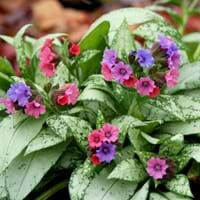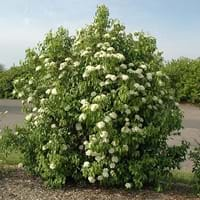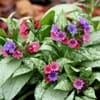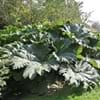Life Span
Perennial
Perennial
Origin
Hybrid origin
Northeastern United States, Mid-Atlantic United States, Southeastern United States, North-Central United States, Central United States, Canada
Types
Benediction lungwort, Excalibur lungwort
Arrowwood Viburnum, American Cranberrybush, European Cranberrybush
Number of Varieties
Not Available
Habitat
Forest edges, Mountains
Rocky areas, Stream side, Woodlands
USDA Hardiness Zone
4-8
2-8
Sunset Zone
1a, 1b, 2a, 2b, 3a, 3b, 4, 5, 6, 7, 8, 9, 14, 15, 16, 17
1a, 1b, 2a, 2b, 3a, 3b, 4, 5, 6, 7, 8, 9, 14, 15, 16, 17, 18, 19, 20, 21
Habit
Cushion/Mound-forming
Oval or Rounded
Flower Color
Pink, Rose, Blue Violet
White
Flower Color Modifier
Not Available
Bicolor
Fruit Color
Not Available
Green, Light Yellow, Pink, Blue Violet, Black
Leaf Color in Spring
Green, Gray Green, Silver
Green
Leaf Color in Summer
Green, Gray Green, Silver
Green
Leaf Color in Fall
Green, Gray Green, Silver
Red, Purple
Leaf Color in Winter
Light Green
Not Available
Leaf Shape
Lung shaped
Ovate
Plant Season
Spring, Summer, Fall
Spring, Summer, Fall
Sunlight
Partial Sun, Partial shade, Full Shade
Partial Sun, Partial shade
Growth Rate
Fast
Not Available
Type of Soil
Clay, Loam, Sand
Clay, Loam, Sand
The pH of Soil
Acidic, Neutral, Alkaline
Acidic, Neutral, Alkaline
Soil Drainage
Well drained
Average
Bloom Time
Early Spring, Spring, Late Winter
Spring, Late Spring
Tolerances
Drought
Drought
Where to Plant?
Ground
Ground
How to Plant?
Divison, Seedlings
Seedlings
Plant Maintenance
Medium
Medium
Watering Requirements
Water when soil is dry, when new, water every week
Do not water frequently
In Summer
Drought Tolerant
Ample Water
In Spring
Average Water
Average Water
In Winter
Adequately
Moderate
Soil pH
Acidic, Neutral, Alkaline
Acidic, Neutral, Alkaline
Soil Type
Clay, Loam, Sand
Clay, Loam, Sand
Soil Drainage Capacity
Well drained
Average
Sun Exposure
Partial Sun, Partial shade, Full Shade
Partial Sun, Partial shade
Pruning
Remove damaged leaves, Remove dead branches, Remove dead leaves
Cut limbs, Remove damaged leaves, Remove dead branches
Fertilizers
All-Purpose Liquid Fertilizer
as it is a flowering plant, use high phosphorous content fertilizer
Pests and Diseases
Powdery mildew, Slugs
Downy mildew, fungus, Powdery mildew, Red blotch, Rust
Plant Tolerance
Drought
Drought
Flower Petal Number
Single
Not Available
Foliage Texture
Coarse
Medium
Foliage Sheen
Matte
Matte
Attracts
Not Available
Birds, Butterflies
Allergy
Not Available
no allergic reactions
Aesthetic Uses
Showy Purposes
Showy Purposes
Beauty Benefits
Not Available
Not Available
Environmental Uses
Air purification, Provides ground cover
Food for birds, Wildlife, Windbreak
Medicinal Uses
Astringent, Demulcent, Diaphoretic, Diuretic, Emollient, Exoectorant, Homeopathy, Opthalmic, Resolvent
Asthma, Cramps, Diuretic, Fever, Nerve sedative, Palpitation
Part of Plant Used
Leaves
Flowers, Fruits
Other Uses
Used for its medicinal properties
Used As Food, Used for its medicinal properties
Used As Indoor Plant
No
No
Used As Outdoor Plant
Yes
Yes
Garden Design
Edging, Groundcover, Mixed Border, Rock Garden / Wall
Feature Plant, Foundation, Fruit / Fruit Tree, Hedges, Screening / Wind Break
Botanical Name
PULMONARIA 'Berries and Cream' PP10597
VIBURNUM lentago
Common Name
Berries and Cream Lungwort, Lungwort
Nannyberry
In Hindi
Lungwort
Nannyberry
In German
Lungenkraut
Nannyberry
In French
pulmonaire
alisier
In Spanish
Lungwort
Nannyberry
In Greek
Lungwort
Nannyberry
In Portuguese
pulmonária
Nannyberry
In Polish
płucnik
Nannyberry
In Latin
Lungwort
Nannyberry
Phylum
Ascomycota
Magnoliophyta
Class
Ascomycetes
Magnoliopsida
Order
Peltigerales
Dipsacales
Family
Boraginaceae
Caprifoliaceae
Genus
Pulmonaria
Viburnum
Clade
Angiosperms, Asterids, Eudicots
Angiosperms, Asterids, Eudicots
Tribe
Boragineae
Not Available
Subfamily
Boraginoideae
Not Available
Number of Species
Not Available
Season and Care of Lungwort and Nannyberry
Season and care of Lungwort and Nannyberry is important to know. While considering everything about Lungwort and Nannyberry Care, growing season is an essential factor. Lungwort season is Spring, Summer and Fall and Nannyberry season is Spring, Summer and Fall. The type of soil for Lungwort is Clay, Loam, Sand and for Nannyberry is Clay, Loam, Sand while the PH of soil for Lungwort is Acidic, Neutral, Alkaline and for Nannyberry is Acidic, Neutral, Alkaline.
Lungwort and Nannyberry Physical Information
Lungwort and Nannyberry physical information is very important for comparison. Lungwort height is 25.50 cm and width 30.50 cm whereas Nannyberry height is 370.00 cm and width 240.00 cm. The color specification of Lungwort and Nannyberry are as follows:
Lungwort flower color: Pink, Rose and Blue Violet
Lungwort leaf color: Green, Gray Green and Silver
Nannyberry flower color: White
- Nannyberry leaf color: Green
Care of Lungwort and Nannyberry
Care of Lungwort and Nannyberry include pruning, fertilizers, watering etc. Lungwort pruning is done Remove damaged leaves, Remove dead branches and Remove dead leaves and Nannyberry pruning is done Cut limbs, Remove damaged leaves and Remove dead branches. In summer Lungwort needs Drought Tolerant and in winter, it needs Adequately. Whereas, in summer Nannyberry needs Ample Water and in winter, it needs Moderate.





